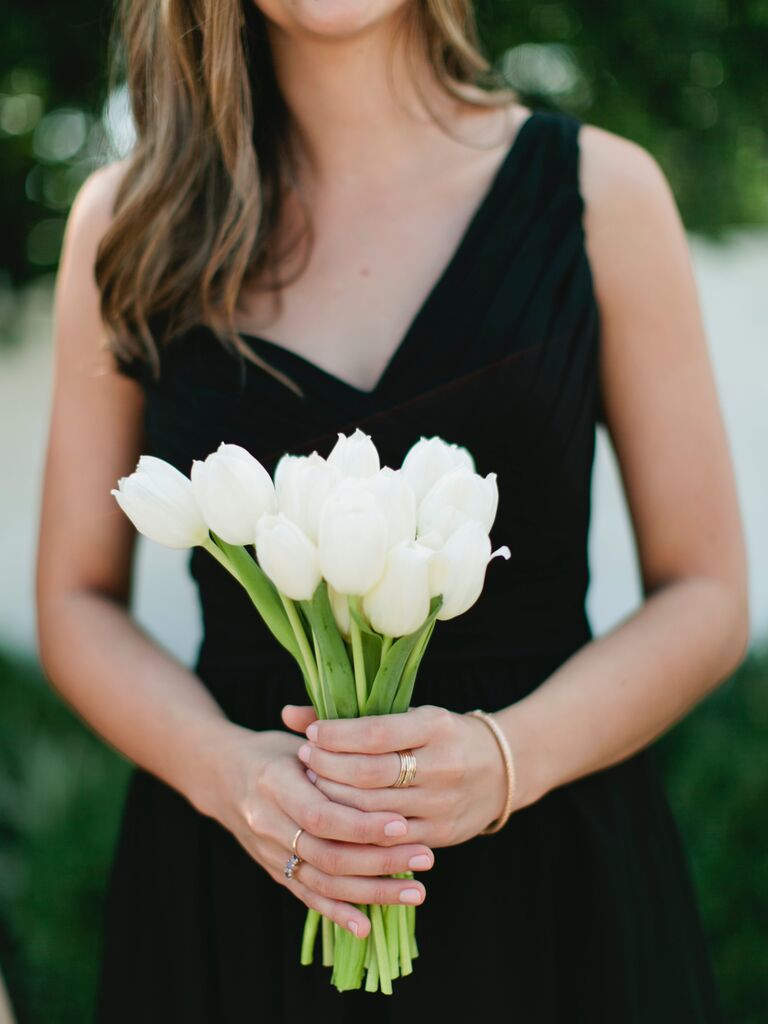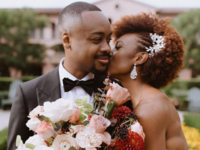11 Styles, Shapes & Types of Wedding Bouquets to Know Before Hiring Your Florist

Carrying your very own wedding bouquet is a special moment to look forward to on the big day. And while it's important to leave the actual design to a pro wedding florist, it's helpful to know the common types of wedding bouquets, plus the popular wedding bouquet shapes and sizes, so that you can best describe what you're looking for when the time comes. No two wedding bouquets are ever exactly the same, which means your wedding florist will be creating something completely custom just for you. Finding a wedding florist you love is the first step toward carrying a bouquet that's beyond your wildest dreams. On The Knot Vendor Marketplace, you can search wedding florists by city or state and filter for vendors who specialize in bouquets in the drop-down Flower Arrangements section. Ready for wedding bouquet ideas? We've outlined different kinds of wedding bouquets, along with a printable guide and photos from real weddings to help you visualize each option.
Different types of wedding bouquets: Printable Guide | Biedermeier | Cascade | Composite | Hand-Tied | Hoop | Nosegay | Oversized | Pageant | Pomander | Posy | Round
Different Types of Wedding Bouquets: Printable Guide on Styles, Shapes & Sizes
Before we get into the specifics, here's a quick overview of the different types of bouquets for weddings. Bookmark or print this bouquet guide for easy reference.

1. Biedermeier Wedding Bouquet
For this type of wedding bouquet, flowers in the same variety (or different varieties, but same color) are clustered together in rings that encircle the bouquet, forming a somewhat striped effect. It works best with brightly colored flowers to create a circular design of alternating bands, like a bulls-eye design. The biedermeier bouquet is one of the less common types of bouquets, but it's a standout option if you're looking for something undoubtedly one of a kind.
2. Cascade Wedding Bouquet

This bouquet style is an upside-down teardrop-shaped design that's wider and rounder at the top, tapering into a narrow point toward the bottom. The blooms and greenery are anchored by a handheld base at the top, allowing the flowers to "spill" over your hand and arm like a waterfall. Cascade bouquets are oversized and vary in length, with greenery and flowers extending either halfway down the front of your body or almost touching the floor. They're a popular option for making an entrance—case in point: Princess Diana famously carried a cascading bridal bouquet of gardenias, stephanotis, myrtle and ivy that was rumored to be more than 40 inches long.
3. Composite Wedding Bouquet

A composite bouquet is constructed using individual petals plucked from multiple flowers to create the illusion of an oversized bloom on a single stem. The petals, which are glued or wired together, create a finished product called a "glamelia." The bouquet resembles a larger version of whichever type of flower the petals came from (for example, single rose petals were used to create this rose glamelia). It's a very artistic wedding bouquet style that's ideal if you want an arrangement your guests won't forget.
4. Hand-Tied Wedding Bouquet

Sometimes known as a garden wedding bouquet, the hand-tied wedding bouquet is one of the most popular types of bridal bouquets. It's a go-to for couples and wedding florists who prefer natural, loose designs, as if the flowers were just picked from the garden (hence the name). This medium-sized wedding bouquet focuses on using blooms and greenery in various stem lengths to create a bouquet that's slightly asymmetrical and lush.



Rather than using a wire mechanic or bouquet holder to make the arrangement, the florist will typically build the bouquet directly in their hand by layering and criss-crossing the stems. This gives the bouquet a more natural look that isn't overly styled—although the technique definitely takes practice. Garden roses, peonies, dahlias and ranunculus are some of the most popular blooms for hand-tied bouquets, along with greenery, blooming branches and foraged elements. Most arrangements are tied with long ribbons that are left to hang loose, enhancing the free-flowing shape.
5. Hoop Wedding Bouquet
For this type of wedding bouquet, flowers are attached to a hoop or wreath instead of bundling the flowers together by the stems. The hoop is carried by hand or slipped onto the wrist for easy transport. Hoop wedding bouquets are popular for boho wedding themes and often chosen by couples looking for modern wedding bouquet styles.
6. Nosegay Wedding Bouquet
The nosegay bouquet is a small cluster of flowers that are all cut to a uniform length. Usually made with one dominant flower or color (and minimal to no greenery), nosegay stems are wrapped tightly with ribbon or other fabric for a polished effect. Because of its smaller size, this wedding bouquet style is great for flowers on a budget.
7. Oversized Wedding Bouquet
Oversized wedding bouquets are large, asymmetrical arrangements with flowers and greenery that extend beyond the central shape. These freeform-style bouquets typically use unexpected and nontraditional elements, like dried grasses and branches, to complement the fresh flowers. Although they started out as a popular wedding flower trend, oversized bouquets are now a go-to design for boho vibes.
8. Pageant Wedding Bouquet
This long-stemmed wedding bouquet is designed to be balanced on one arm instead of carried by hand. Also known as an arm sheaf or presentation bouquet, pageant wedding bouquets are inspired by the large arrangements given to pageant winners when they're crowned onstage. Presentation bouquets are typically very full arrangements, primarily designed with stalk-like flowers, such as roses, calla lilies, gladiolus, delphinium, foxgloves and flowering tree branches.
9. Pomander Wedding Bouquet

The pomander bouquet has 360 degrees of flowers, resembling a whimsical, bloom-covered ball. Thanks to the handy ribbon loop at the top, this spherical type of wedding bouquet is easy to carry, making it a perfect option for young wedding attendants like flower girls. You can also hang pomanders from shepherd's hooks, chair backs or pews, which is why they're a popular choice for ceremony aisle markers and other wedding decor.
10. Posy Wedding Bouquet
These small wedding bouquets can easily be held in one hand, which usually isn't the case for larger, heavier bouquets, like cascade and hand-tied arrangements. While the posy bouquet is similar in size to a nosegay, it's a more loosely designed bouquet with greenery and a less-rounded shape. The smaller wedding bouquet size makes posies a popular choice for bridesmaid bouquets. Plus, they're perfect for showing off your wedding day look, since the petite arrangement won't block your dress.
11. Round Wedding Bouquet

As one of the most traditional bouquet types, the round bridal bouquet is a favorite for classic and formal wedding styles. The medium-size bouquet should be perfectly symmetrical when viewed from the side and above, with all of the flowers at an even height. Round bouquets feature little to no greenery to avoid interfering with their curved shape. To finish, the bouquet stems are tightly wrapped with satin or other ribbon, which you can embellish with brooches or charms.


























